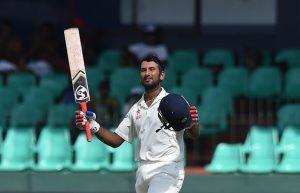Cheteshwar Pujara – A ‘class act’
View : 112
2 Min Read


Cheteshwar Pujara – A ‘class act’: Since the time Cheteshwar Arvind Pujara made his entry into international cricket in October 2010, in the second Test against Australia in Bengaluru, he has been an integral part of the Indian dressing room in the longer format of the game.
For a player who has featured in 50 Test innings and has amassed 2,218 runs at an average of 49.28 with 206* being his individual best, it would be really ‘heart-wrenching’ to be warming the bench and delivering the drinks.
This is more so when some players who fail to deliver time and again, get the nod of the team management to be a part of the Playing XI, just for the fact that they are classified as ‘form is temporary, class is permanent.’ What use is that ‘class’ if it cannot deliver?
Pujara, 27, after a knee injury forced him to be out of 2011 season, made his comeback to the Indian team with a century (159 runs) in the first innings of the First Test against the visiting New Zealand at Hyderabad in 2012, which India won by an innings and 115 runs. He had scored 216 runs in three innings in that series.
He also scored an unbeaten double century (206*) against England in the first innings of the first Test at Ahmedabad in the 2012-13 series. He followed it up with a century (135) in the first innings of the second Test at Mumbai. He accumulated 438 runs in the seven innings in that series.
Pujara continued his good form in the 2013 Test series against Australia at home and scored the second double ton (204) of his career in the third Test at Hyderabad. Playing in 7 innings in that series, he accumulated 419 runs. He gradually became a prolific run scorer at home for India batting at No 3.
Cheteshwar proved to be the highest run-getter for India in the ‘away’ Test series in South Africa in late 2013. This was against one of the best bowling attack in the world. He had accumulated 280 runs in the four innings that he played which included a century (153 runs) in the second innings of the first Test at New Wanderers Stadium. Johannesburg.
Thereafter his form slumped and was a clear disappointment in the ‘away’ series’ against England in 2014 and Australia in 2014-15.
In the ten innings in England, he scored only 222 runs with just one half century (55).
In the disastrous Border-Gavaskar Trophy 2014-15 played Down Under, Pujara featured in the first three Test matches and could score only 201 runs in six innings. He was dropped for the Final Test at Sydney.
Returning from Australia, April/May 2015, saw Pujara turning up for Yorkshire County. He ended the stint with an unbeaten century (133*) against Hampshire on 10th May 2015.
His county performance was taken into consideration and he found himself travelling along with the Indian Test squad to Bangladesh for a lone test in June, 2015.
However, the Team India test skipper, Virat Kohli, surprised everyone by including Rohit Sharma in the Playing XI, in place of Pujara.
Senior member of the team, Ravichandran Ashwin, at that point of time had remarked, ‘You have to leave four people out because you’re picking from a 15-man squad. I’ve been left out in the past. Different people have been left out at different times. It’s not like you actually look out for sympathy and say Oh my God, this guy has to sit out. That’s not how the game goes. Not trying to be harsh, but I’m speaking the truth’.
‘Today it was unfortunate that Pujara had to sit out and tomorrow he might play. If you have to play five bowlers, you sacrifice a batsman. As simple as that’.
Pujara, who was once looked upon as the replacement for Rahul ‘The Wall’ Dravid at No. 3 position in Tests, was expected to make a comeback to the Playing XI for the one-off Test against Bangladesh. But that was not to be.
Subsequently Australia A team undertook a tour of India. Pujara led India A in two unofficial Test matches played in July 2015. While the first game was drawn, Australia A won the second game by 10 wickets.
However, Pujara accumulated 119 runs in four innings.
Subsequently Pujara found himself travelling to Sri Lana for the three-Test Cricbuzz series. However, the team management felt that Rohit Sharma was better equipped to be in the Playing XI and hence used Pujara for the ‘drinks’ services in the first two Tests.
An injury to both the regular openers Murali Vijay and Shikhar Dhawan opened up the opportunity for Pujara.
The Team India management in Colombo were benevolent enough to include him in the Playing XI for the Third and Final Test.
Pujara grabbed the opportunity that came his way with both hands and proved to one and all that he is made of a different material
He was rock solid and blocked one end, while wickets went on tumbling at the other. His innings brought back memories of Rahul ‘The Wall’ Dravid, who had played this role umpteen number of times during his career.
In the process, the 27-year old, went on to register his 7th century (145* runs off 289 deliveries, 14*4) in his 28th Test match and ‘carried the bat’.
Pujara, registered the highest score by an Indian batsman in this series.
Rohit Sharma’s failure (once again) and Pujara’s success to tackle the conditions, throws open a debate as to who should be an integral of the Playing XI, in the Mahatma Gandhi-Nelson Mandela ‘home’ series against South Africa.
Though it is not very difficult to answer this question, it would be really interesting to see how the ‘five wise men’ in BCCI and the Team management react at the appropriate time.
Download Our App